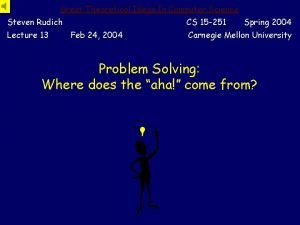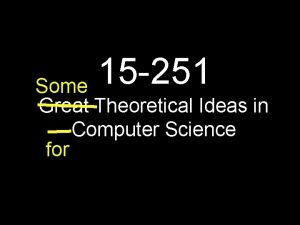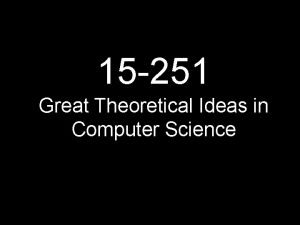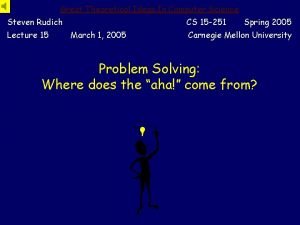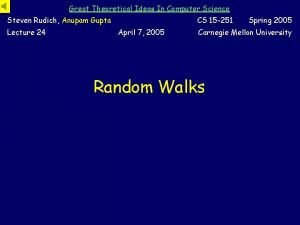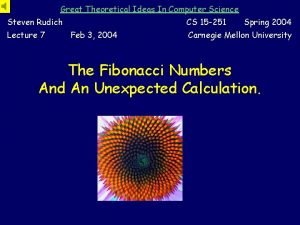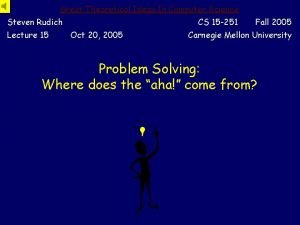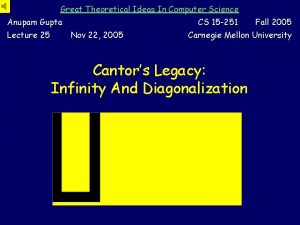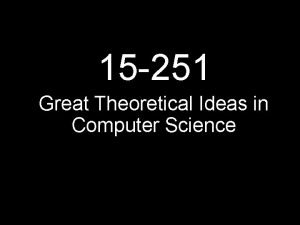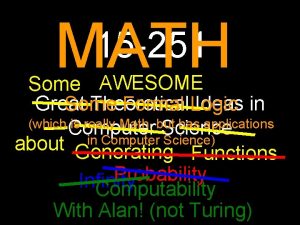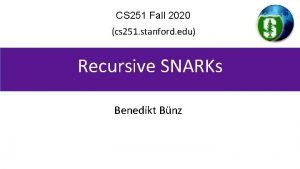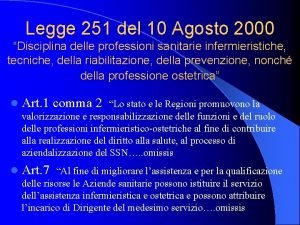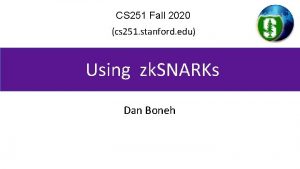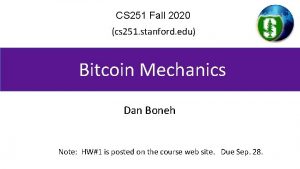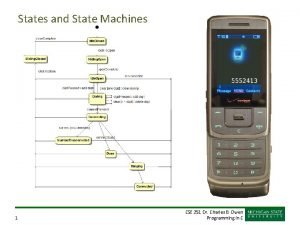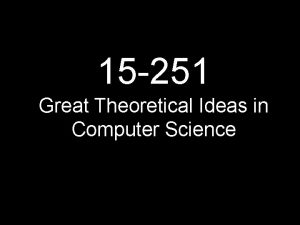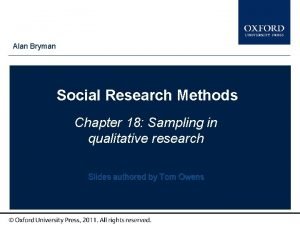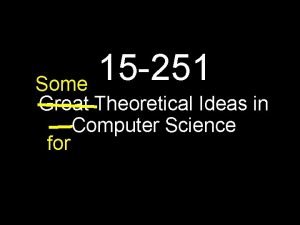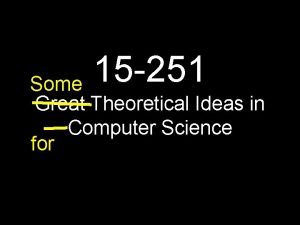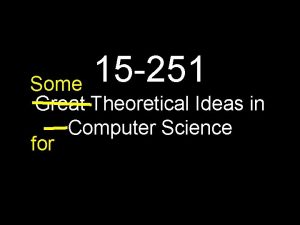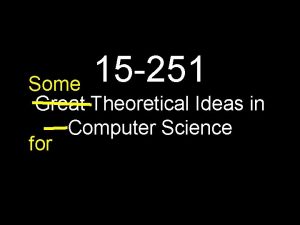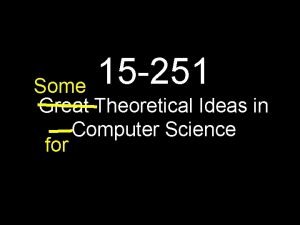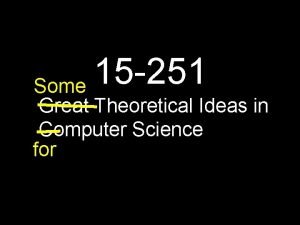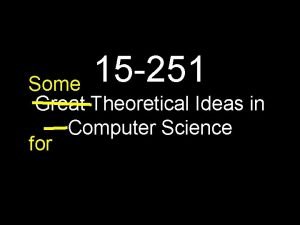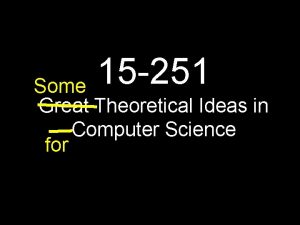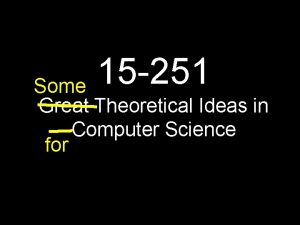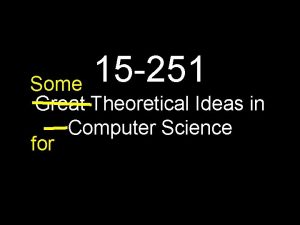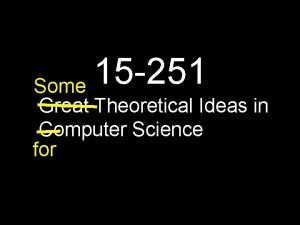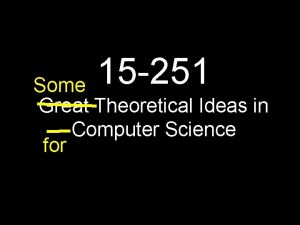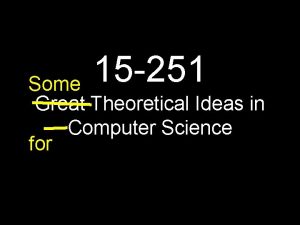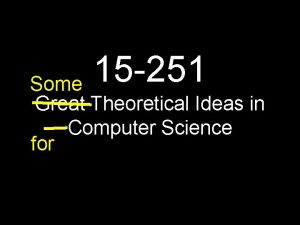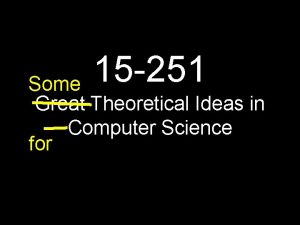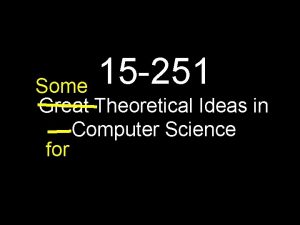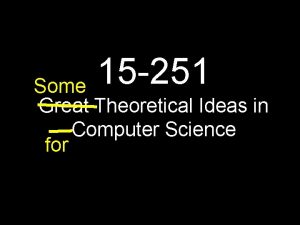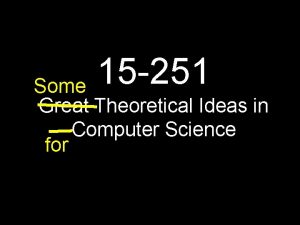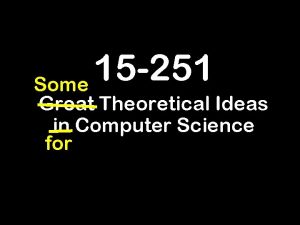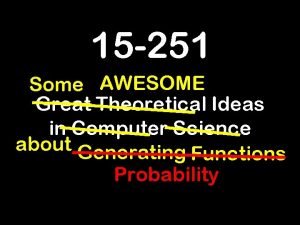15 251 Some Great Theoretical Ideas in Computer



![Public Key Cryptography Secret M Private Key Public Key P EP[M] Public Key Cryptography Secret M Private Key Public Key P EP[M]](https://slidetodoc.com/presentation_image_h/9c215df7485906a6cf57eb09a8039323/image-4.jpg)






![Modular Equivalence a b [mod n] (a mod n) = (b mod n) n|(a-b) Modular Equivalence a b [mod n] (a mod n) = (b mod n) n|(a-b)](https://slidetodoc.com/presentation_image_h/9c215df7485906a6cf57eb09a8039323/image-11.jpg)
















































- Slides: 59

15 -251 Some Great Theoretical Ideas in Computer Science for

Modular Arithmetic and the RSA Cryptosystem Lecture 17 (March 18, 2008) p-1 p 1

Public Key Cryptography -----BEGIN PGP PRIVATE KEY BLOCK----Version: PGP 8. 1 - not licensed for commercial use: www. pgp. com l. QHNBEOed. R 4 RBAC 6 bfed 3 ULz. Ow. VF/Bouy. O 8 kfs 8 wk. Omk 3 va. MF 6+6 Jye. EJqy. Ima. Vh p. Vh. U 7 lst 6 Qt. XTy. AF 734 Ft. Cl. M/9 Dq 9 Dn 7 GDo. O 3 E 9+n. GVO 7 w. J 1 OT+X 4 lgkoi. M 68 WWG -----BEGIN PGP PUBLIC KEY BLOCK----eio. T 958 Hg 0 zq 0 Kqu. HUBFM+Kldc+nr 0 e 0 Q 6 u. Cgw. IYM 7 o. H 60/WX 8 e 2 Wnvycw. Cgzba 0 Version: PGP 8. 1 - not licensed for commercial use: www. pgp. com k. Rzx. Ntmw 9 w 9 IEQUk 9 pa 2 CK 8 D/2 Fj. Rxt. EDN 6 n. Y 7/l 1 w. Urk. Mj. I/u. XYns. NWwr. IAbw. Hp qh. UZQYst 27 Xpw. Npl. Am. I 6 Yu. S+3 O+L 4 vg. URj 1 h. Vcn. NG+2 b. ZXjbt 4 Fg 3 RLhr. TV/jiu. L m. QGi. BEOed. R 4 RBAC 6 bfed 3 ULz. Ow. VF/Bouy. O 8 kfs 8 wk. Omk 3 va. MF 6+6 Jye. EJqy. Ima. Vh oh. Bay. AAd. ZZ 4+72 Cja 1+18 xp 700 GVTF 96 j. Yc 8 d. Iox. Nx 1 Ag. Hz. QUffj 3 Gnsc. Azo 7 ud 3 p. Vh. U 7 lst 6 Qt. XTy. AF 734 Ft. Cl. M/9 Dq 9 Dn 7 GDo. O 3 E 9+n. GVO 7 w. J 1 OT+X 4 lgkoi. M 68 WWG Hy. YHA/9 s. I 6 Gijh/ubr 1 q. Tz. Hw. ZPdil. Djfn. Ey. Qw. R 6+for. UUegw. CO 0 Yaws. C 2 l. G 6 F 7 MG eio. T 958 Hg 0 zq 0 Kqu. HUBFM+Kldc+nr 0 e 0 Q 6 u. Cgw. IYM 7 o. H 60/WX 8 e 2 Wnvycw. Cgzba 0 q 3 RHn. JSw. I 3 Di. H/g. Y 5 b. Yk 3 Xxhink. Kxqk 54 Di. L 6 vr. HIw/E 9 J 6 Raz. Y+ocic. LRZ+6 Xj. O k. Rzx. Ntmw 9 w 9 IEQUk 9 pa 2 CK 8 D/2 Fj. Rxt. EDN 6 n. Y 7/l 1 w. Urk. Mj. I/u. XYns. NWwr. IAbw. Hp JPXp. K 8 s 2 v 64 p. H 5 gyrsf. ANw. STTy. ECPx/hp 2 G+0 BW/mt. MU+Jq. FPP 8 DAw. Kvg. RN 08 a. TW qh. UZQYst 27 Xpw. Npl. Am. I 6 Yu. S+3 O+L 4 vg. URj 1 h. Vcn. NG+2 b. ZXjbt 4 Fg 3 RLhr. TV/jiu. L 1 WAW 5/ak/URD 4 OAOT 6 OXlyg 4 Ywha. Jodb 9 vfwck 4 V 8 bn. NLVNhb. XBs. ZSBTZWN 1 cm. VC oh. Bay. AAd. ZZ 4+72 Cja 1+18 xp 700 GVTF 96 j. Yc 8 d. Iox. Nx 1 Ag. Hz. QUffj 3 Gnsc. Azo 7 ud 3 b. GFja 2 Jve. CBQR 1 Aga 2 V 5 PGlu. Zm 9 AZWxkb 3 Mu. Y 29 t. Pp 0 DJg. RDnn. Wk. EAg. Ax. Iw. Ism. EC Hy. YHA/9 s. I 6 Gijh/ubr 1 q. Tz. Hw. ZPdil. Djfn. Ey. Qw. R 6+for. UUegw. CO 0 Yaws. C 2 l. G 6 F 7 MG m. LGf. QMH 6 Gf. Nqn 8 XG 9/bv. T/n. L/m 7 Tj. UVv 1 JGr. KDASb. ASs. Pl. YLn. Del 4 opyp 24 Azu 5 x q 3 RHn. JSw. I 3 Di. H/g. Y 5 b. Yk 3 Xxhink. Kxqk 54 Di. L 6 vr. HIw/E 9 J 6 Raz. Y+ocic. LRZ+6 Xj. O n. Q 0/Qls. Oifm. Xj. INc. Wz. Nt. Wc. Jk. W 3 r. Bam. P 1 Vw 6 Zhx. N 8 e 1 ARRrxw. On 42 V/yn/Ho. MFH 0 O JPXp. K 8 s 2 v 64 p. H 5 gyrsf. ANw. STTy. ECPx/hp 2 G+0 BW/mt. MU+Jq. FPM 0 t. U 2 Ftc. Gxl. IFNl Hhm 2 M 5 r 8 W/r. Oxo 4 d. Pd. KPm. RPd. Ma. PVMndg. M 8 Wc. OGPJ 6 Tb. Mb 4 g 9 hphb+E 4 o 3 gl. I 6 fh. P Y 3 Vy. ZUJs. YWNr. Ym 94 IFBHUCBr. ZXk 8 a. W 5 mb 0 Blb. GRvcy 5 jb 20+wkk. EEBECABMCm. QEF 41 GZy 57 w. Wd. KY 9 Dn. Q 3 W 2 PGo. Fa. FAl. Qdy. Atekz. Omixp 2/j. Xpq 4+br 9 Yd 088 Unp 2 sw 4 Z Ak. Oeda. QJEKl 84 Zsq. Net 0 AAAROg. Cgg. Fc. JOrmv. Nvpdm. ADv 0 i. Ez. VUVci+g. Ao. JDD 9 wbm 56 j 8 s. Ab. Tk 7 NFpc. TUSxsn. FXpi. Gr 0 Wk. V+qf. Dy. YTBv. En. FXItei. Th. AWYz. Jgge 6 Tb 6 qz. L WOq 7 M 06 k 4 r. SOZSj 2 me 0 Gu. QINBEOeda. QQCADEj. Aiy. YQKYs. Z 9 Awfo. Z 82 qfxcb 39 u 9 P 1 Xj. D 5 u. R 1 z 2 Fg. Tw. ACAgf/f. GBk. Ve 8 y. ETYw. ARrcn 0 x. Xv 991 AEv. A 4 wl. NI 0/gyg. JKXx. TV +cv+bt. ONRW/Ukaso. MBJs. BKw+Vguc. N 6 Xiin. Knbg. DO 7 n. Gd. DT 9 CWw 6 J+Ze. Mg 1 xb. M 21 Z 0 w. TImds. Ons. Ksxt. TCKdch. SCFRu. GYs. BPzc 7 l. Us. PKk 4 j. Nk. Av 1 EZELhq. Hk. ZTC 51 t. EPx. A wm. Rbes. Fq. Y/VXDpm. HE 3 x 7 UBFGv. HA 6 fj. ZX/Kf 8 egw. Uf. Q 4 e. Gb. Yzmvxb+s 7 Gjh 090 o+Z m 3/i 8 i. AYFz 2 r. TPf. Zkrj. BJ 2 x. P 6 Ch. Rqmj 0 BTc. Zjo 3 bz. Rwjl. UMTej. Ga. R 9 BQDq. B 9 A 59 z E 90 xo 9 Uyd 2 Azx. Zw 4 Y 8 np. Nsxvi. D 2 Gm. Fv 4 Tije. CUjp+E/j. UZn. Lnv. BZ 0 pj 0 Od. Ddb. Y 8 a 2 r. CBn 6 nz 9 f 6 F+1 o. Z 62 g. Thj. S 6 WUb. Ubh. BKCwvfnt. Fs. XFrp. XWHr 5 Apv+5 zbxte. Td. Hr 0 g. Vo. UCVB 3 IC 16 TM 6 a. LGnb+Nemrj 5 uv 1 h 3 Tzx. Senaz. Dhnnq. Pyw. Bt. OTs 0 Wlx. NRLGyc. V 1 x 3 NRl 0 Rzvz. J 4 w. Q 4 Ws. VFi. ZFI 3 l 7 Hyk. Rd 37 XE+h. Sv. RSr 2 i. Wq. E/Pd. R 7 alx. Aswc 5 LET em. Iav. Ra. RX 6 p 8 PJh. MG 8 Sc. Vci 16 JOEBZj. Mm. CB 7 p. Nvqr. Mv. Ve. MPm 5 HXPYWBPAAICB/98 GCH//3 xz. P 1/7 Au 3 XLUa. D 4 La. Fo. XY 1 b. IBui 2 Srmu 1 kc. P 8 DAw. IYqv. VK 6 L 5 Df 2 Cejm. Tt YGRV 7 z. IRNj. ABGtyf. TFe/33 UAS 8 Dj. CU 0 j. T+DKAkpf. FNXTBMi. Z 2 w 6 ewqz. G 1 MIp 1 y. FI hi. A 1 DBn. Nck 4 d. F 7 g. POa. Yku 6 Rfw 27 EOvh. Wmd. Z 1 pp 13 uw 2 Tm 6 SEBo. G 7 rkq 1 a 01 UWEjs IVG 4 Ziw. E/Nzu. VSw 8 q. Ti. M 2 QC/URk. Qu. Goe. Rl. MLn. W 0 Q/ECbf+Ly. IBg. XPat. M 99 m. Su. MEn Ph. UPkfxh. VT 6 q. Hd 4 Bs 3 EOGSh 7 s. NFsv 8 Ibb. Ay. P 3 r. POtbt 3 m 9 t 02 x. Ez. Kl 5 ZOq. D 85 EZC b. E/o. KFGqa. PQFNxm. Ojdv. NHCOVQx. N 6 MZp. H 0 FAOo. H 0 Dn 3 Pas. IGfqf. P 1/o. X 7 Whnra. BOG HYK/l 6 l. LD 8 p. UX 2 d. JQq. Zw. TN 4 lkdl 99 HOf 7 XYPx. Hv. Cmbh 1 S 1 Cg. TM 3 H 2 wc 5 M 7 QROMhr NLp. ZRt. Ru. EEo. LC 9+e 0 Wxc. Wuld. Yevk. Cm/7 n. Nv. G 15 N 0 ev. TXHc 1 GXRHO/Mnj. BDhax. UWJ -----END PGP PRIVATE KEY BLOCK-----END PGP PUBLIC KEY BLOCK-----
![Public Key Cryptography Secret M Private Key Public Key P EPM Public Key Cryptography Secret M Private Key Public Key P EP[M]](https://slidetodoc.com/presentation_image_h/9c215df7485906a6cf57eb09a8039323/image-4.jpg)
Public Key Cryptography Secret M Private Key Public Key P EP[M]

The RSA Cryptosystem Rivest, Shamir, and Adelman (1978) RSA is one of the most used cryptographic protocols on the net. Your browser uses it to establish a secure session with a site.

Pick secret, random large primes: p, q “Publish”: n = p*q (n) = (p) (q) = (p-1)*(q-1) Mumbo jumbo… Pick random e Z* (n) “Publish”: e Compute d = inverse of e in Z* (n) More Mumbo jumbo… Hence, e*d = 1 [ mod (n) ] “Private Key”: d

But how does it all work? What is φ(n)? What is Zφ(n)*? … Why do all the steps work? To understand this, we need a little number theory. . .

MAX(a, b) + MIN(a, b) = a+b n|m means that: m is an integer multiple of n. (We say that “n divides m”. )

Greatest Common Divisor: GCD(x, y) = greatest k ≥ 1 such that k|x and k|y Least Common Multiple: LCM(x, y) = smallest k ≥ 1 such that x|k and y|k Fact: GCD(x, y) × LCM(x, y) = x × y You can use MAX(a, b) + MIN(a, b) = a+b to prove the above fact.

Modulus (a mod n) means: the remainder when a is divided by n If a = dn + r with 0 ≤ r < n Then r = (a mod n) and d = (a div n)
![Modular Equivalence a b mod n a mod n b mod n nab Modular Equivalence a b [mod n] (a mod n) = (b mod n) n|(a-b)](https://slidetodoc.com/presentation_image_h/9c215df7485906a6cf57eb09a8039323/image-11.jpg)
Modular Equivalence a b [mod n] (a mod n) = (b mod n) n|(a-b) Written as a n b, and spoken “a and b are equivalent modulo n” Example: 31 81 [mod 2] 31 2 81

n is an Equivalence Relation In other words, it is: Reflexive: a n a Symmetric: (a n b) (b n a) Transitive: (a n b and b n c) (a n c) n induces a partition of Z into n classes a and b are said to be in the same “residue class” or “congruence class” when a n b

a n b n|(a-b) “a and b are equivalent modulo n” Define Residue class [i] = the set of all integers that are congruent to i modulo n Residue Classes Mod 3: [0] [1] [2] [-6] [7] [-1] = { …, -6, -3, 0, 3, 6, . . } = { …, -5, -2, 1, 4, 7, . . } = { …, -4, -1, 2, 5, 8, . . }

Fact: equivalence mod n implies equivalence mod any divisor of n. If (x n y) and (k|n) then: x k y Example: 10 6 16 10 3 16 Proof: x n y n|(x-y) k|(x-y) x k y

Fundamental lemma of plus, minus, and times mod n: If (x n y) and (a n b), then: 1. x + a n y + b 2. x - a n y – b 3. x * a n y * b When doing plus, minus, and times modulo n, you can at any time replace a number with a number in the same residue class modulo n What is (249)(504) mod 251? When working mod 251: (-2)(2) = -4 = 247

A Unique Representation System Modulo n: We pick exactly one representative from each residue class. We do all our calculations using these representatives.

Unique Representation System Modulo 3 Finite set S = {0, 1, 2} + and * defined on S: + 0 1 2 0 0 1 2 1 1 2 0 2 2 0 1 * 0 1 2 0 0 1 0 1 2 2 0 2 1

Unique Representation System Modulo 3 Finite set S = {0, 1, -1} + and * defined on S: + 0 1 -1 0 0 1 -1 1 1 -1 0 -1 -1 0 1 * 0 1 -1 0 0 1 0 1 -1 -1 0 -1 1

Perhaps The Most Convenient Set of Representatives The reduced system modulo n: Zn = {0, 1, 2, …, n-1} Define operations +n and *n: a +n b = (a+b mod n) a *n b = (a*b mod n)

The Reduced System Modulo 2 Z 2 = {0, 1} Two binary, associative operators on Z 2: +2 0 1 *2 0 1 0 0 0 1 1 0 1

The Reduced System Modulo 2 Z 2 = {0, 1} Two binary, associative operators on Z 2: +2 0 1 *2 0 0 1 1 1 0 XOR 0 1 0 0 0 1 AND

The Reduced System Z 4 = {0, 1, 2, 3} + 0 1 2 3 * 0 1 2 3 0 0 0 1 1 2 3 0 1 2 3 2 2 3 0 1 2 0 2 3 3 0 1 2 3 0 3 2 1

The Reduced System Z 6 = {0, 1, 2, 3, 4, 5} + 0 1 2 3 4 5 0 0 1 2 3 4 5 1 1 2 3 4 5 0 2 2 3 4 5 0 1 3 3 4 5 0 1 2 4 4 5 0 1 2 3 5 5 0 1 2 3 4 An operator has the permutation property if each row and each column has a permutation of the elements. For every n, +n on Zn has the permutation property

What about multiplication? Does *6 on Z 6 have the permutation property? * 0 1 2 3 4 5 0 0 0 0 1 2 3 4 5 2 0 2 4 3 0 3 0 3 4 0 4 2 5 0 5 4 3 2 1 NO!

What about *8 on Z 8? * 0 1 2 3 4 5 6 7 3 0 3 6 1 4 7 2 5 4 0 4 0 4 0 1 2 5 6 7 Which rows have the permutation property?

A visual way to understand multiplication and the “permutation property”.

The multiples of c modulo n is the set: {0, c, c +n c, …. } = {kc mod n | 0 ≤ k ≤ n-1} There are exactly 8 distinct multiples of 3 modulo 8: 0 7 1 2 6 5 Hit all numbers row 3 has the “permutation property” 3 4

There are exactly 2 distinct multiples of 4 modulo 8 0 7 1 2 6 5 3 4

There is exactly 1 distinct multiple of 8 modulo 8 0 7 1 2 6 5 3 4

There are exactly 4 distinct multiples of 6 modulo 8 0 7 1 2 6 5 3 4

There number of distinct multiples of c modulo n is: LCM(n, c)/c = n/GCD(c, n) Hence only those values of c with GCD(c, n) = 1 have the permutation property for *n on Zn

Theorem: There are exactly k = n/GCD(c, n) = LCM(c, n)/c distinct multiples of c modulo n, and these are: { c*i mod n | 0 ≤ i < k } Proof: Clearly, c/GCD(c, n) ≥ 1 is a whole number ck = cn/GCD(c, n) = n(c/GCD(c, n)) n 0 So there at most k multiples of c mod n: c*0, c*1, c*2, …, c*(k-1) Also, k = all the factors of n missing from c cx n cy n|c(x-y) k|(x-y) x-y ≥ k Hence, there are exactly k multiples of c.

Fundamental lemma of plus, minus, and times mod n: If (x n y) and (a n b), then: 1. x + a n y + b 2. x - a n y – b 3. x * a n y * b

Is there a fundamental lemma of division modulo n? cx n cy x n y ? Of course not! If c=0[mod n], cx n cy for all x and y. Canceling the c is like dividing by zero.

Let’s Fix That! Repaired fundamental lemma of division modulo n? if c 0 [mod n], then cx n cy x n y ? 6*3 10 6*8, but not 3 10 8 2*2 6 2*5, but not 2 6 5 This also doesn’t work!

When Can’t I Divide By c? Theorem: There are exactly n/GCD(c. n) distinct multiples of c modulo n Corollary: If GCD(c, n) > 1, then the number of multiples of c is less than n Corollary: If GCD(c, n) > 1 then you can’t always divide by c. Proof: There must exist distinct x, y < n such that c*x=c*y (but x y). Hence can’t divide.

Fundamental lemma of division modulo n: if GCD(c, n)=1, then ca n cb a n b Proof: ca n cb n|(cb-ca) n|c(b-a) n|(b-a) a n b (because GCD(c, n)=1)

Fundamental lemma of division modulo n: if GCD(c, n)=1, then ca n cb a n b Consider the set: Zn* = {x Zn | GCD(x, n) =1} Multiplication over this set Zn* will have the cancellation property

Z 6 = {0, 1, 2, 3, 4, 5} Z 6* = {1, 5} * 0 1 2 3 4 5 0 0 0 0 1 2 3 4 5 2 0 2 4 3 0 3 0 3 4 0 4 2 5 0 5 4 3 2 1

Z 12* = {0 ≤ x < 12 | gcd(x, 12) = 1} = {1, 5, 7, 11} *12 1 5 7 11 1 1 5 7 11 5 5 1 11 7 7 7 11 1 5 11 11 7 5 1

Z 5* = {1, 2, 3, 4} = Z 5 {0} *5 1 2 3 4 1 1 2 3 4 2 2 4 1 3 3 3 1 4 2 4 4 3 2 1 For all primes p, Zp* = Zp {0}, since all 0 < x < p satisfy gcd(x, p) = 1

Euler Phi Function (n) Define (n) = size of Zn* (number of 1 ≤ k < n that are relatively prime to n) If p is prime, then (p) = p-1

Z 12* = {0 ≤ x < 12 | gcd(x, 12) = 1} = {1, 5, 7, 11} *12 1 5 7 11 1 1 5 7 11 5 5 1 11 7 7 7 11 1 5 11 11 7 5 1 (12) = 4

Theorem: if p, q distinct primes then: (pq) = (p-1)(q-1) Proof: # of integers from 1 to pq: pq # of multiples of q up to pq: p # of multiples of p up to pq: q # of multiples of both p and q up to pq: 1 (pq) = pq – p – q + 1 = (p-1)(q-1)

Additive Inverse The additive inverse of a Zn is the unique b Zn such that a +n b n 0. We denote this inverse by “–a” It is trivial to calculate: “-a” = n-a

Multiplicative Inverse The multiplicative inverse of a Zn* is the unique b Zn* such that a *n b n 1 We denote this inverse by “a-1” or “ 1/a” The unique inverse of “a” must exist because the “a” row contains a permutation of the elements and hence contains a unique 1. * 1 b 3 4 1 1 2 3 4 2 2 4 1 3 a 3 1 4 2 4 4 3 2 1

Efficient Algorithm To Compute a-1 From a and n Run Extended Euclidean Algorithm on the numbers a and n It will give two integers r and s such that ra + sn = gcd(a, n) = 1 Taking both sides modulo n, we obtain: ra n 1 Output r, which is the inverse of a

Fundamental Lemmas Until Now If (x n y) and (a n b), then: 1. x + a n y + b 2. x - a n y – b 3. x * a n y * b For a, b, c in Zn* then ca n cb a n b

If (a n b) then xa n xb ? NO! (2 3 5) , but it is not the case that: 22 3 25

Euler’s Theorem: a Zn*, a (n) n 1 Fermat’s Little Theorem: p prime, a Zp* ap-1 p 1

Fundamental Lemma of Powers: If a (n) b Then xa n xb Equivalently, xa n xa mod (n)

What is 2444441 mod 5? xa (mod n) = xa mod (n) (mod n) 444441 (5) 1 So 2444441 mod 5 = 2

Negative Powers Suppose x Zn*, and a, n are naturals. x-a is defined to be the multiplicative inverse of xa x-a = (xa)-1

Rule of Integer Exponents Suppose x, y Zn*, and a, b are integers: (xy)-1 n x-1 y-1 Xa Xb n Xa+b

The RSA Cryptosystem

Pick secret, random large primes: p, q “Publish”: n = p*q (n) = (p) (q) = (p-1)*(q-1) Pick random e Z* (n) “Publish”: e Compute d = inverse of e in Z* (n) Hence, e*d = 1 [ mod (n) ] “Private Key”: d

p, q random primes, e random Z* (n) n = p*q e*d = 1 [ mod (n) ] n, e is my public key. Use it to send me a message.

p, q prime, e random Z* (n) n = p*q e*d = 1 [ mod (n) ] n, e me [mod n] (me)d n m message m

Working modulo integer n Definitions of Zn, Zn* and their properties Fundamental lemmas of +, -, *, / When can you divide out How to calculate c-1 mod n. Here’s What You Need to Know… Fundamental lemma of powers Euler phi function (n) = |Zn*| Euler’s theorem Fermat’s little theorem RSA algorithm
 Great theoretical ideas in computer science
Great theoretical ideas in computer science Great ideas in theoretical computer science
Great ideas in theoretical computer science Great theoretical ideas in computer science
Great theoretical ideas in computer science Great theoretical ideas in computer science
Great theoretical ideas in computer science Great theoretical ideas in computer science
Great theoretical ideas in computer science Great theoretical ideas in computer science
Great theoretical ideas in computer science Great theoretical ideas in computer science
Great theoretical ideas in computer science Great theoretical ideas in computer science
Great theoretical ideas in computer science Great theoretical ideas in computer science
Great theoretical ideas in computer science Great theoretical ideas in computer science
Great theoretical ideas in computer science 8 ideas of computer architecture
8 ideas of computer architecture Cse 111
Cse 111 Task level parallelism
Task level parallelism 8 great ideas in computer architecture
8 great ideas in computer architecture 8 great ideas in computer architecture
8 great ideas in computer architecture 15-251
15-251 A vida tem tristezas mil letra
A vida tem tristezas mil letra Stanford cs 251
Stanford cs 251 Anupam saxena
Anupam saxena Legge 251 del 2000
Legge 251 del 2000 Cs251 stanford
Cs251 stanford Aecp requirements
Aecp requirements Cs 251 stanford
Cs 251 stanford Aae 251 purdue
Aae 251 purdue Cs 251
Cs 251 15-251
15-251 Theoretical computer science
Theoretical computer science They say it only takes a little faith to move a mountain
They say it only takes a little faith to move a mountain God when you choose to leave mountains unmovable
God when you choose to leave mountains unmovable Ice cream is a countable or uncountable noun
Ice cream is a countable or uncountable noun Contact vs noncontact forces
Contact vs noncontact forces Fire and ice diamante poem
Fire and ice diamante poem Some say the world will end in fire some say in ice
Some say the world will end in fire some say in ice Some may trust in horses
Some may trust in horses Ideas have consequences bad ideas have victims
Ideas have consequences bad ideas have victims Que son las ideas complementarias
Que son las ideas complementarias Unit 4 great ideas
Unit 4 great ideas Turning great strategy into great performance
Turning great strategy into great performance South dakota state symbols
South dakota state symbols Responsible leadership meaning
Responsible leadership meaning Great hammerhead vs great white size
Great hammerhead vs great white size Does alexander the great deserve his title
Does alexander the great deserve his title Frederick the great catherine the great enlightened despot
Frederick the great catherine the great enlightened despot With great expectations comes great responsibility
With great expectations comes great responsibility A great deal vs a great many
A great deal vs a great many With great power comes great responsibility batman
With great power comes great responsibility batman Does alexander deserve to be called the great
Does alexander deserve to be called the great Oh god my father how great great is your faithfulness
Oh god my father how great great is your faithfulness 3 components of computer system
3 components of computer system Difference between a computer and computer system
Difference between a computer and computer system The large program that controls how the cpu communicates
The large program that controls how the cpu communicates Basic structure of a computer system
Basic structure of a computer system Difference between organization and architecture
Difference between organization and architecture Design of basic computer with flowchart
Design of basic computer with flowchart Complete computer description in computer organization
Complete computer description in computer organization Theortical yield
Theortical yield How to write theoretical framework
How to write theoretical framework World english paradigm
World english paradigm Welding terminology and definitions
Welding terminology and definitions Generic purposive sampling
Generic purposive sampling

